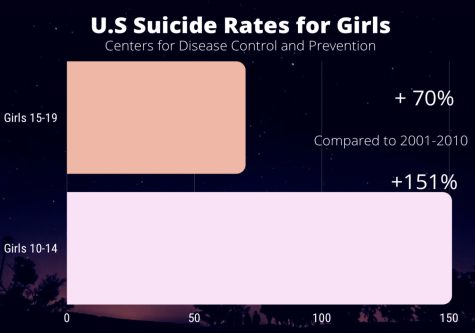Behind the Screens, What Does Social Media Really Do to Teenage Girls?
By the time Erin Michelena, a sophomore at Mayfield Senior, gets to school, she’s checked her social media apps four times. On the way to school, during school, after school, and before bed, checking social media is a way of life for teen girls.
“It starts as something to do and becomes more of an obligation,” Zoe Griffin ’24 said. In fact, more than 40% of Mayfield girls report an average use of 4-6 hours on social media.
Even though social media apps may seem like harmless ways to keep up with current society, they also have very negative effects on teens’ mental and psychological health.
“I’ve witnessed and observed cyberbullying over social media,” Marina Mauridian ’23 said.
“I’ve seen the direct effects of how harmful the effect of those couple messages or images can have on a person.”
The effects of social media ranging from cyberbullying, depression, suicide, and substance addiction are worse for girls. According to a study done by Northwestern University, more frequent social media use disproportionately affects teen girls’ mental health more negatively than that of teen boys.

Broken down: social media presents itself as a highlight reel. It’s a cycle in which every like, comment, or follower has significant value and it just keeps on repeating. The more users see this perceived value of perfection, the more it damages self-worth — especially for teenage girls.
Not only is social media becoming more toxic, but there is also a certain pressure or expectation that comes with having it according to school psychologist, Erica Mastrobuono, who said that even though usage may not be enjoyable, many feel compelled to have social media. Out of the 93 Mayfield students surveyed, 64.8% feel obligated to use social media.
“Social media is a way that people connect,” Mastrobuono said. “Unfortunately, it does not only foster connection, but it also increases comparison to others, fear of missing out, and an addiction like the feeling of needing to always be available and/or to know what others are doing at every minute.”
Rather than all or nothing, as technology and social media remain more prevalent in the lives of teenage girls, The American Academy of Pediatrics (AAP) urges schools to provide safe and effective educational programs through which students can learn to identify and mitigate the onset of mental health impacts caused by social media usage. Having these resources allow girls to build healthy habits and find boundaries. Shifting topics that correspond with social media could also help reverse effects.
The top priority, said psychologist, Mastrobuono, needs to be turning social media from a negative environment to a positive one before the situation becomes unmanageable. Finding the line where users can differentiate where social media ends and reality begins is crucial.

Chloe Leong is a senior at Mayfield Senior School and the current Co-Editor in chief for Cubs Student News. She is part of the Advanced Journalism class...

